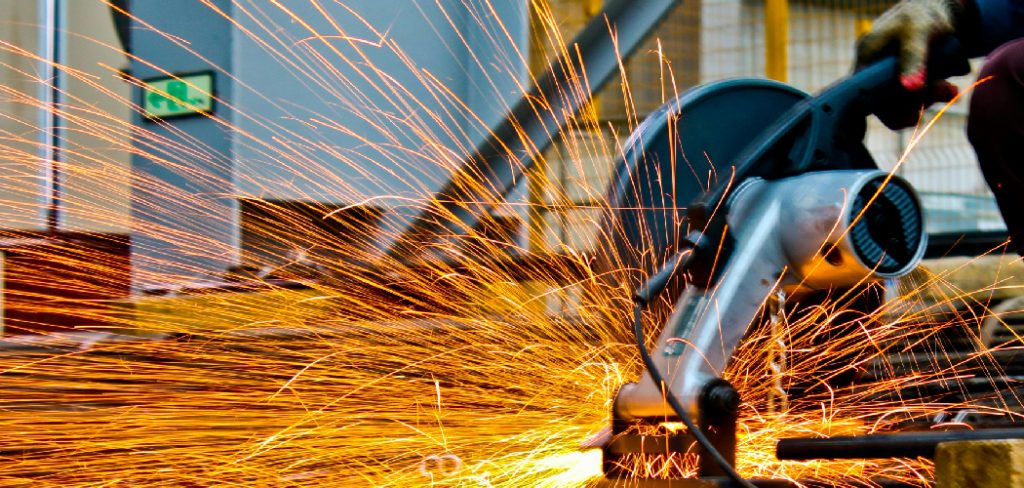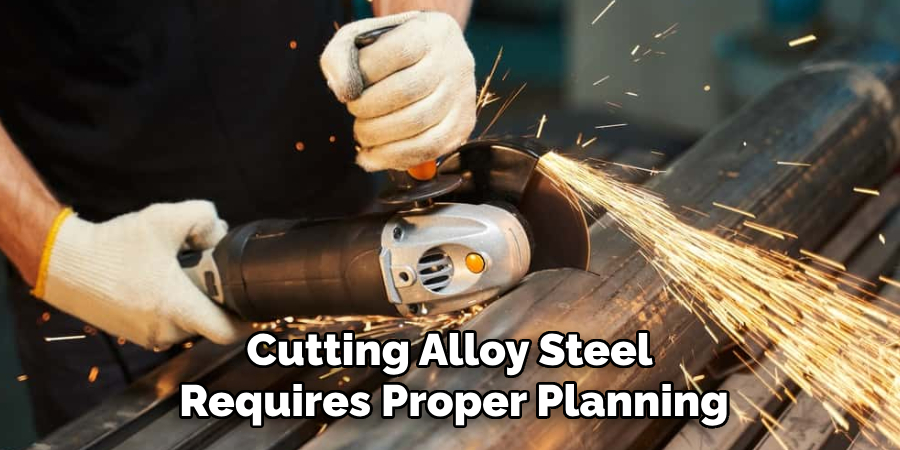Cutting alloy steel requires a careful approach due to its durability and resistance to wear. Alloy steel is a versatile material used in a variety of applications, from automotive components to construction materials, owing to its enhanced mechanical properties derived from the addition of elements like chromium, nickel, and molybdenum. When planning to cut alloy steel, it’s important to select the right tools and techniques to ensure precision and safety.

This guide on how to cut alloy steel will explore the methods and equipment needed to effectively cut alloy steel, providing tips for both beginners and experienced metalworkers. Whether you’re working on a large-scale industrial project or a small DIY task, understanding the basics of cutting alloy steel can help achieve the best results.
Why is Cutting Alloy Steel Challenging?
Cutting alloy steel can be a challenging task due to its high strength and hardness, which makes it more resistant to traditional cutting methods. Unlike regular carbon steel, alloy steel contains additional elements that increase its toughness and durability, making it ideal for heavy-duty applications.
However, these same properties also make it difficult to cut using conventional tools and techniques. It’s crucial to understand the specific characteristics of alloy steel when planning to cut it.
Tools and Equipment Required
Saw Blades:
One of the most common ways to cut alloy steel is by using saw blades specifically designed for this purpose. These blades are made from high-speed metals like M2 or M3, which have the strength and durability to cut through tough alloy steel. When selecting a saw blade, make sure it’s suitable for the thickness of the alloy steel you’re working with.
Plasma Cutters:
Plasma cutting is another popular method for cutting alloy steel. This process involves using a high-velocity jet of ionized gas (plasma) that heats and melts the metal, creating a clean and precise cut. Plasma cutters are available in different sizes and power capacities, so choose one based on your project requirements.
Laser Cutters:
Laser cutting is a highly accurate method for cutting alloy steel, making it ideal for intricate designs or shapes. This process uses a powerful laser beam to melt and vaporize the metal, leaving a clean and smooth cut. While laser-cutting machines can be expensive, they offer excellent precision and efficiency.
Water Jet Cutting:
Water jet cutting is a versatile method that uses a high-pressure stream of water to cut through various types of materials, including alloy steel. It’s a cold-cutting process that doesn’t produce heat or create thermal distortion in the metal, making it ideal for delicate or intricate cuts.

8 Simple Steps on How to Cut Alloy Steel
Step 1: Wear Protective Gear
Before beginning any cutting task, it is crucial to prioritize safety by wearing the appropriate protective gear. This includes safety goggles to protect your eyes from metal shards, heat-resistant gloves to prevent burns, and a face shield to guard against sparks.
Additionally, wearing a long-sleeve shirt, pants, and safety boots will help protect your skin from any hot metal or debris that may result from the cutting process. Ensuring your safety gear is up to standard will allow you to work confidently and reduce the risk of injury.
Step 2: Plan and Mark Your Cutting Area
Before starting the cutting process, it’s essential to plan and clearly mark the area you intend to cut on the alloy steel. Begin by measuring the steel accurately using a tape measure or a ruler, ensuring that all your dimensions are precise. Use a marker or chalk to draw straight, visible lines on the steel where the cuts need to be made. This will serve as a guide during cutting, helping to maintain accuracy throughout the process.
Make sure the marked lines are easily visible from your work position and consider using a straightedge or guide to ensure that your markings are perfectly straight. Proper planning and marking will not only improve the precision of the cut but also make the process more efficient and safer.
Step 3: Secure the Alloy Steel
Before cutting, secure the alloy steel in a vice or clamp to prevent it from moving during the cutting process. This will ensure that the steel remains stable and avoid any potential accidents. Make sure to position the marked lines above the clamp so they are visible while you cut.
Otherwise, the vice or clamp may interfere with your cutting and make it difficult to achieve precise cuts.
Step 4: Choose the Appropriate Cutting Tool
Selecting the right tool for cutting alloy steel is crucial to ensure a clean and accurate cut. While saw blades, plasma cutters, laser cutters, and water jet cutters are all viable options, consider the thickness of the steel you’re working with and choose a tool that can handle it effectively.
If you’re not sure which tool is best for your project, consult an expert or do some research beforehand to avoid any complications during cutting.
Step 5: Adjust Cutting Speed and Pressure
When using a saw blade or plasma cutter, it’s crucial to adjust the cutting speed and pressure according to the thickness of the alloy steel. Cutting too fast can result in an uneven or rough cut while cutting too slow can cause excessive heat buildup and lead to warping or distortion of the metal.

Make sure to follow manufacturer recommendations for your specific tool and adjust as needed during the cutting process.
Step 6: Begin Cutting
With all safety precautions in place and your tools properly set up, it’s time to start cutting. Follow your marked lines and begin slowly cutting through the alloy steel using steady and consistent movements. Keep an eye on the cutting speed and pressure to ensure a clean and precise cut.
If you’re using a saw blade, make sure to lubricate the blade regularly to prevent overheating and prolong its lifespan.
Step 7: Check Your Progress
Periodically check your progress as you cut through the alloy steel. This will help you maintain accuracy and ensure that you’re following your marked lines correctly.
If needed, adjust your cutting speed or pressure or switch tools if the current one isn’t producing satisfactory results.
Step 8: Finishing Touches
Once you’ve completed cutting through the alloy steel, carefully remove it from the vice or clamp and inspect it for any rough edges or imperfections. Use a file to smooth out any rough edges or sandpaper to create a clean and smooth finish.
Properly dispose of any metal scraps or debris, and store your cutting tools in a safe place for future use. With these simple steps on how to cut alloy steel, you can successfully cut through alloy steel with precision and efficiency.
Tips for Cutting Alloy Steel
- Always wear proper protective gear when working with alloy steel to prevent injuries from flying debris.
- Ensure your workpiece is securely clamped before starting the cutting process to prevent movement or vibrations.
- Use appropriate cutting fluid or lubricant when using saw blades to prevent overheating and extend the life of your blade.
- When using a plasma cutter, make sure the metal is properly grounded to prevent electrical hazards.
- Consider consulting an expert or doing extensive research before choosing a cutting tool for your specific project.
- Practice proper maintenance and care for your cutting tools to ensure optimal performance and longevity.

Frequently Asked Questions
Q1: Can I Use a Regular Saw Blade to Cut Alloy Steel?
A: While it is possible to use a regular saw blade, it is not recommended. Alloy steel is much harder than standard steel and requires specialized cutting tools for clean and precise cuts. Using a regular saw blade may result in an uneven or rough cut and potentially damage the blade.
Q2: What is the Best Cutting Tool for Alloy Steel?
A: The best cutting tool for alloy steel depends on the thickness of the metal and the desired precision of the cut. Some popular options include plasma cutters, laser cutters, and water jet cutters. Consult an expert or do research to determine which tool is best for your specific project.
Q3: How Do I Dispose of Metal Scraps and Debris After Cutting?
A: Properly dispose of metal scraps and debris by recycling them or taking them to a scrapyard. It is important to dispose of these materials safely to prevent potential harm to the environment. Ultimately, cutting alloy steel requires proper planning, accurate marking, and the use of appropriate tools and techniques. With these steps in mind, you can confidently tackle any project that involves cutting through this durable and versatile metal. Remember to always prioritize safety and consult experts or do research if needed for the best results.

Conclusion
Cutting alloy steel may seem daunting at first, but by following these simple steps and safety precautions, you can achieve precise cuts with ease. Remember to wear proper protective gear, plan and mark your cutting area, choose the right tool for the job, adjust cutting speed and pressure accordingly, and periodically check your progress.
With these tips on how to cut alloy steel, you can successfully cut through alloy steel and complete your project with accuracy and efficiency. So next time you need to work with alloy steel, approach the task with confidence and be sure to prioritize safety throughout the entire process. Happy cutting! Remember, stay safe and have fun creating!
Edmund Sumlin is a skilled author for Metal Fixes, bringing 6 years of expertise in crafting a wide range of metal fixtures. With a strong background in metalwork, Edmund’s knowledge spans various types of fixtures, from decorative pieces to functional hardware, blending precision with creativity. His passion for metalworking and design has made him a trusted resource in the industry.
Professional Focus:
- Expert in Metal Fixtures : Edmund aesthetic specializes in creating durable and innovative metal fixtures, offering both appeal and functionality. His work reflects a deep understanding of metalworking techniques and materials.
- Sustainability Advocate : He is dedicated to using sustainable practices, ensuring that every fixture is crafted with eco-friendly methods while maintaining high-quality standards.
In his writing for Metal Fixes, Edmund provides valuable insights into the latest trends, techniques, and practical advice for those passionate about metal fixtures, whether they are professionals or DIY enthusiasts. His focus on combining artistry with engineering helps others discover the true potential of metal in design.


